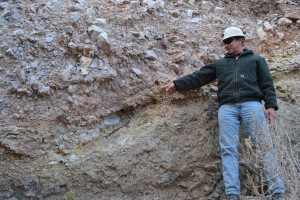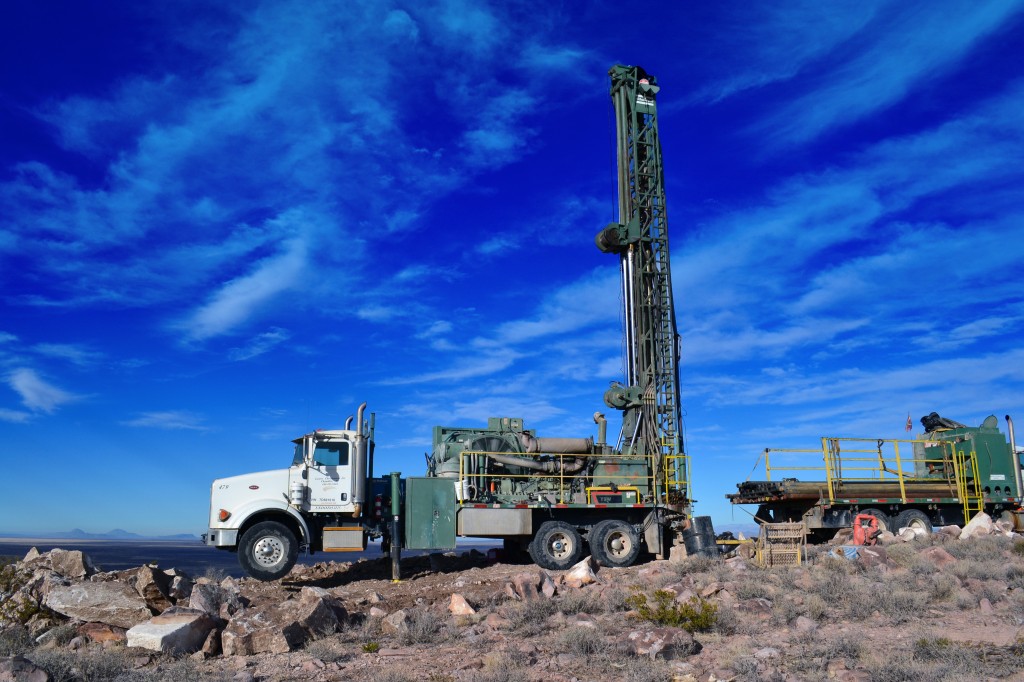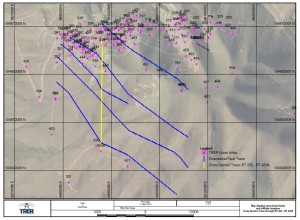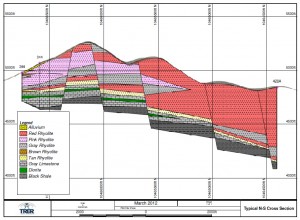Geology / Mineralization
The Round Top project, Texas Mineral Resourcess Corp.’s (TMR’s) flagship project, is one of five rhyolite laccoliths known as the Sierra Blanca Peaks that lie within the Texas Lineament Zone or Trans-Pecos trend. The Texas Lineament Zone is a northwest trending structural zone which formed as a result of Laramide thrust faulting followed by basin and range normal faulting. All five Sierra Blanca laccoliths were intruded into Cretaceous age sedimentary strata. McAnulty (1980) suggests the laccoliths were emplaced during Oligocene or early Miocene time.
Round Top is an asymmetrical rhyolite laccolith that increases in thickness from north to south. The laccolith is concordantly floored with Cretaceous age sediments of the Washita Group. Drilling conducted by Cyprus Minerals determined the two formations that floor the intrusive are the Del Rio and Buda Limestone Formations. Recent drilling conducted by TMR confirms the floor of the intrusive is the Del Rio and Buda Limestone and the intrusion is offset by faulting.
Structure Geologic modeling based on historical drilling data and drilling conducted by TMR shows the floor of the intrusion dips to the south. This southward dipping floor causes the rhyolite body to increase in thickness to the south. Drilling on the west side of the mountain suggests the rhyolite intrusion could extend below the surface expression of Round Top peak. In addition, the model shows the intrusion is displaced by fault structures.
An aeromagnetic survey conducted by TMR shows the Round Top intrusion follows a northwest-striking structure. This structure extends beyond Round Top to the northwest and southeast of the mountain. The magnetic survey also revealed a buried intrusive body to the southeast of Round Top between Little Blanca and Sierra Blanca peaks. The Round Top intrusion was most likely structurally controlled and was probably intruded from a rhyolite sill extending from a feeder dike located between the Sierra Blanca Peaks.
A number of northwest-striking faults cut across Round Top Peak. These faults probably formed from extensional stresses during late Larimide basin and range normal faulting after the rhyolite was emplaced. Drilling shows vertical displacement along these faults can be as great as 200 feet. Exploration conducted by Cyprus Minerals revealed one of these northwest-striking fault structures to be related to the beryllium mineralization in the Buda Limestone. The surface expression of these faults often shows fluorite mineralization and can be radioactive. The fluorite mineralization suggests these structures hosted a late-stage-hydrothermal event and may be related to beryllium and uranium mineralization along the floor of the Round Top intrusion.
Rhyolite Composition Molecular proportional calculations based on whole rock analysis show the Round Top rhyolite to be peralkaline. The Round Top rhyolite is enriched in trace elements consisting of Li, F, Rb, Y, Zr, Nb, Sn, Ta, Pb, Ga, lanthanides (HREE, LREE), Th, and U. In addition to these trace elements, cryolite, Li-rich micas with variable Fe contents, rutilated quartz, and vapor rich fluid inclusions defining quartz overgrowths are found in the Round Top rhyolite. The presence of these minerals suggests the rhyolite was chemically modified by pegmatitic-phase crystallization. The Round Top rhyolite has a pegmatitic composition that is conducive for the concentration of rare earth elements, especially heavy rare earths.
Exposed Trench Wall, Mineralized Contact between Sedimentary Rock and Rhyolite, Round Top, North Side
Rare Earth Mineralization* Price, et al. (1990) and Rubin, et al. (1987) report the Round Top rhyolite to be enriched in rare earth elements (REEs), especially heavy rare earths (HREEs). They suggest the intrusion has potential to be a low-grade, bulk-tonnage resource* for HREE. A preliminary metallurgical study on the Round Top rhyolite was conducted by TMR. As part of this study the rare earth mineralogy was investigated. The result of this mineralogical study showed the rare earth elements to be in the minerals yttrofluorite, yttrocerite and bastnaesite. Other rare earth minerals identified by Rubin, et. al. (1987) include priorite and xenotime. The mica was also found to be enriched in rare earth elements. Other minerals identified were cassiterite, changbaiite, columbite, coronadite, cryolite, kasolite, tantalite, thorite, fluorite and zircon. The rare earth minerals are evenly distributed throughout the rhyolite and the assay results from the historical and TMR drilling program reflect the even distribution of these minerals. The rare earth minerals can be associated with fluorite, columbite and cryolite. The thorite was found to occur as inclusions in the zircon and is not associated with the rare earth minerals.

Beryllium Mineralization* Located in the northwest part of the Round Top laccolith, Rubin, et. al. (1990) describes beryllium mineralization with potential economic importance. The beryllium minerals are hosted by fluorspar replaced limestone and rhyolite that occurs along the contact between the rhyolite and the Buda Limestone Formation. This contact is a steeply dipping fault, exposing a cross section of the Buda Limestone to mineralization and is part of the laccolith floor. Fluorspar replacement extends for 23 feet into the limestone and grades into recrystallized and unaltered limestone. The rhyolite was incompletely fluoritized with only the feldspar phenocrysts being replaced. Along the contact, the rhyolite and limestone is brecciated and the breccias are cemented with fluorite. Parallel to the steeply dipping contact, bands of hydrothermal minerals commonly occur in the replaced limestone.
Mineral assemblages reported by Rubin et. al. (1990) from within the ore body were identified from diamond drill core, rotary drill cuttings, exposures in bulldozer cuts, and an exploratory adit. The dominant mineral is fluorite followed by quartz as veinlets of chalcedony. Five beryllium minerals were reported to occur in the mineralized limestone: behoite, berborite, bertrandite, chrysoberyl and phenakite. The most common minerals are bertrandite and phenakite and are most abundant along the rhyolite-limestone contact. Behoite is abundant further from the contact where it fills open spaces and coats open fractures. Berborite occurs with behoite as a subordinate phase.
There is a possibility that in addition to Round Top, beryllium mineralization may be present on Little Round Top, Little Blanca, and Sierra Blanca. A stream sediment survey conducted by TMR showed a high concentration of trace element assemblages that are conducive to the known beryllium mineralization on Round Top to occur on the north side of Little Blanca. In addition to the stream sediment survey, a prospect pit on the south side of Little Round Top exposes beryllium mineralization in the contact between the rhyolite and sedimentary rocks. This mineralization is represented by brecciated fluorite and behoite filling open spaces in the breccia. Drilling conducted by Cabot in the 1980s found beryllium mineralization on the north side of Sierra Blanca.

Vertical Drill, Round Top Peak, West Side
Uranium Mineralization* Secondary-uranium mineralization associated with the beryllium mineral occurrence is found in the exploration adit on Round Top. Uranium mineralization has also been found in some of the historical and TMR drill holes at the contact between the rhyolite and sedimentary rocks. The uranium mineralization is often found in fluorite and quartz replaced limestone along the floor of the laccolith and is associated with hydrothermally altered rhyolite. The uranium minerals identified by TMR are kasolite and schopite from samples taken near the uranium mineralization exposed in the adit. The minerals were identified by x-ray diffraction at the University of Colorado, Boulder. Other minerals suspected to be present are uranophane and sklodowskite.
As suggested by Rubin et. al., (1987), Round Top is being investigated as having potential to be developed into a low-grade, bulk-tonnage, heavy rare earth element resource.* Due to the potential of developing this deposit into an operating mine, drilling, an aeromagnetic survey, a stream sediment survey and a preliminary metallurgical study was conducted by TMR. The results of these investigations are encouraging and additional studies are underway. The drilling program has been expanded and a second metallurgical study is being conducted.
References Cited
McAnulty, W. N., 1980, Geology and mineralization of the Sierra Blanca Peaks, Hudspeth County, Texas, in Dickerson, P. W., Hoffer, J. M. and Callender, J. F., eds, Trans-Pecos region Southeastern New Mexico and west Texas: New Mexico Geol. Soc. Guidebook thirty-first field conference, p. 263-266.
Price, J. G., Jeffrey, R. N., Henry, C. D., Pinkston, T. L., Tweedy, S. W., and Koppenaal, D. W., 1990, Rare-Metal enriched peraluminous rhyolites in a continental arc, Sierra Blanca area, Trans-Pecos Texas; Chemical modification by vapor-phase crystallization, in Stein, H. J., and Hannah, J. L., eds., Ore bearing granitic systems; petrogenesis and mineralizing processes: Geol. Soc. Amer. Spec. Paper 246 p. 103-120.
Rubin, J. N., Price, J. G., Henry, C. D., and Koppenaal, D. W., 1987, Cryolite bearing and rare metal-enriched rhyolite, Sierra Blanca Peaks, Hudspeth County, Texas, Am. Min., v. 72, p.1122-1130.
Rubin, J. N., Price, J. G., Henry, C. D., and Kyle, J. R., 1990, Geology of the beryllium-rare earth element deposits at Sierra Blanca, west Texas, in Kyle, J. R., ed., Industrial mineral resources of the Delaware Basin, Texas and New Mexico: Soc. Econ. Geol. Guidebook Series v. 8, p. 191-203.
(1) Unless noted, all analyses used in these projections are taken from Price et al, 1990.
(2) Analyses from Shannon, 1986, Unpublished Masters Thesis, University of Texas at El Paso
*See Cautionary Notes to Investors.






